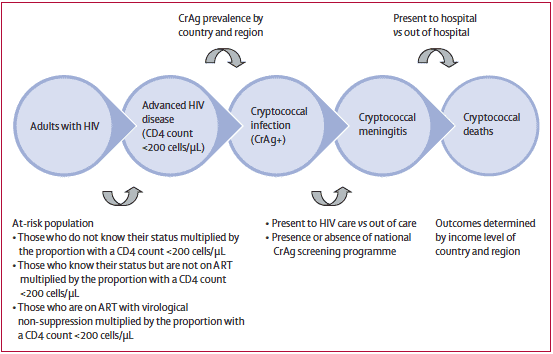Despite remarkable progress in treating more people with HIV infection, an estimated 4.3 million are still at risk of life-threatening fungal, bacterial and viral opportunistic infections, along with TB. In some parts of the world, cryptococcal meningitis is a major killer in AIDS.

The third global estimate of cryptococcal disease, including meningitis, has just been published in Lancet Infectious Diseases by Radha Rajasingham and colleagues. She used a mean global cryptococcal antigenaemia prevalence of 4.4% (with an actual range from 1.2% in Iran to 10.8% in DRC) in those with CD4 counts <200 cells/uL to derive regional and global estimates. From these estimates, those with meningitis and the proportion who die of cryptococcal meningitis were calculated.
Globally, 179,000 cases of cryptococcal antigenaemia were estimated for 2020 with 152,000 cases of meningitis. Unfortunately, the mortality is high because of a lack of diagnosis, continued use of only fluconazole for therapy and other gaps in care and so an estimated 112,000 (74%) of these people die. Although AIDS and HIV mortality has been falling, Rajasingham estimates that cryptococcal disease accounts for 19% of AIDS-related mortality.

Eastern and Southern Africa account for 41% of the cases across the world, but 49% of deaths. This is because an estimated 87% of patients die. In Western Africa, there are fewer cases of meningitis (19,000, 13%) and almost as high a mortality rate (84%).
The countries with the greatest number of cases of cryptococcosis are (in decreasing order) South Africa, India, Mozambique, Indonesia, Kenya, Tanzania, DRC, Ethiopia, Thailand and Zambia.
The authors call for cryptococcal diagnostics, meningitis treatments and preventive screening to be urgently implemented. The target of ending cryptococcal meningitis deaths by 2030 seems elusive currently.